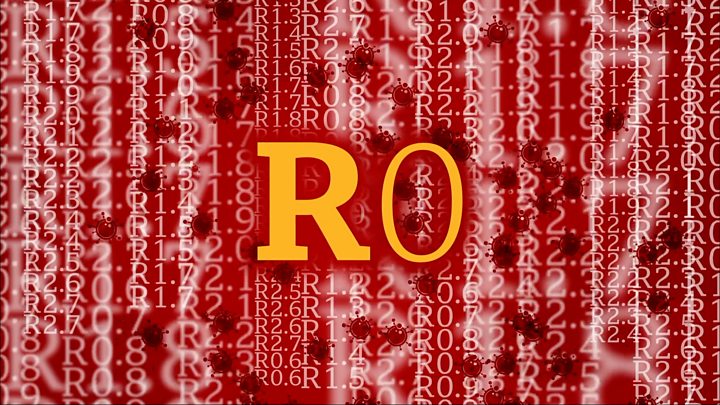 Image copyright Orbon Alija/Getty Images
Image copyright Orbon Alija/Getty Images The rate that coronavirus is being transmitted in the community has been watched keenly by health officials.
It remained steady for weeks but then fell dramatically, compared to what it was at its peak during lockdown. But it has now started to go up again
As of 12 October, the so-called R number was estimated to be 1.37 – it was two or three times that earlier in the pandemic.
The R rate is the average number a sick person could pass the virus on to.
Health Minister Vaughan Gething, said the rate needs to drop below 1 for case numbers to begin falling.
“The measures we have put in place at both a local and a national level to date have helped to keep the spread of the virus under check,” he said.
“But there is growing concern these will not be enough to help us through the winter because the virus is spreading so quickly.
“We could see coronavirus infections reach the same level as the spring peak in just a couple of weeks.”
What is the R number?

Media playback is unsupported on your device
It tells us how many people are likely to get infected from a person who is ill with coronavirus.
So if the R number is R2 – it means a sick person is likely to transmit the virus to two other people. This is how coronavirus spreads.
The lower the number the better – and under one is the aim. As restrictions are lifted, it leads to the R number rising.
So if R is 1 then on average 10 people infected with Covid-19 would pass it on to another 10 people.
But if R is 0.8 then on average 10 people who have caught coronavirus would pass it on to eight others, and so on.
What is the R number in Wales?
It is now 1.37, according to the Welsh Government.
Its scientific advisory group, based on the UK government’s Sage expert body’s estimates, put it as between 1.3 and 1.6 on 2 October.
In September, it had been estimated at being between 0.7 and 1.2, with First Minister Mark Drakeford saying government officials were “confident it is above one”.
Before that, it was estimated at being between 0.7 and 0.9 at the end of July.
Scientists say the R number is useful when coronavirus cases are going up or down but with a low numbers of cases – as over the summer – it was hard to get a good handle on what was happening.
So the lower the number of positive cases, the less useful it is.
But now with cases rising, the R-number and growth rate are seen as more reliable tools again.
This is also why it is also unreliable to try to estimate a R-number for different regions of Wales.
The Welsh Government’s Technical Advisory Cell (Tac) said a low number of cases also means the R number “becomes very sensitive to daily changes” in cases found through tracing, causing it to fluctuate weekly.
Its latest bulletin is cautious because of the low number of cases and the “high degree of uncertainty of the exact value of R”.
According to the most recent estimates, the R number in Wales is lower than regions of England.
Overall in the UK, the R number is higher than one.
What else do we need to look at?
The growth rate. This is also rising and the Sage scientific group estimates the current daily growth rate to be between 0.05 and 0.09 in Wales, indicating that infections could be rising by between 1% and 5% per day.
Meanwhile, the ONS said analysis of thousands of swab results estimate that 6,100 people in Wales had coronavirus in the week to 1 October – about 0.2% or one in 500 people.
The R number in Wales is arrived at by looking at eight different data sources – and it is then a weighted average of estimates.
This includes data from hospitalisations, confirmed cases, deaths, and data from contact surveys, which includes a Welsh sample.
But if you test more people, you are likely to find more cases.
Welsh Government advisers said there was no evidence it was “significantly different” in Wales and other UK nations but there was “greater uncertainty in the estimates” due to the smaller numbers of cases and deaths.
What does it mean for potential deaths?
In September, a “reasonable worst case scenario” was published, after what could happen over the winter and into next spring was modelled by experts at Swansea University.
The worst case looked at 636,000 infections, leading to 18,200 hospital admissions – peaking in January – and potentially 6,300 deaths.
Earlier in the pandemic, the scientific advisers suggested an R of 0.8 would lead to 500 additional coronavirus deaths by the start of August and as many 7,000 if the R number reached 1.1.
Initial estimates earlier in May suggested R 0.8 would lead to 800 more deaths and 7,200 if the rate hit 1.1.
Tac said in its recent report that a consistent R number below 1 would lead to a reduction in cases and hospitalisations, while a consistent R number above 1 would lead to a rise.
But they warn that a small increase in R above 1, maintained for three months, could have a “huge impact” on hospital demand and “greatly increase” the number of hospital admissions and deaths.
What else are the experts saying?
The Sage group of UK scientific advisers is also looking at the speed and how quickly infections are changing each day.
Analysis of data showing travel trends suggested a large rise in travel in early July in Wales. Between mid-May and early June, England saw larger increases in travel.
During July, this mobility increased more in Wales than in England and that continued throughout August.
Tac has also been looking at potential pitfalls from bringing in local lockdowns, with a “lack of motivation” likely without furlough support.
Why has the R number been important?
Earlier in the pandemic, NHS Wales chief executive Dr Andrew Goodall said the R number was an important part of their thinking and any action taken regarding the lockdown would have an impact on transmission rates.
He said there needed to be a “real focus” on that calculation to ensure appropriate judgements were made.
